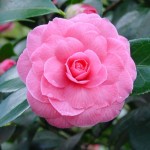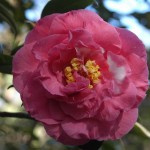Family: Theaceae
Synonymous: Thea japonica
Distribution and habitat: Camellia japonica is a long lived evergreen, large shrub or small tree, native to in mainland China, Taiwan, southern Korea and southern Japan. In the wild, it grows in forests at altitudes of around 3001100m (9803600 feet).
Description: Camellia japonica probably is the most commonly grown species in indoor or patio situations. The leathery, glossy leaves of Camellia japonica which are about 10cm (4 inch) long and 5cm (2 inch) wide, are arranged alternatively on woody stems. Flowers can be solitary or borne in clusters and each bloom can be single (with only 5 petals encircling a mass of yellow stamens) or double (with more than 20 petals and no visible stamens) or semi-double. Flower size varies from about 5-13cm (2-5 inch) across and colour may be white, pink, red or a combination of white and either red or pink.
Houseplant care: Indoor cultivation of Camellia japonica is bound to be plagued by some problems as they are very sensitive to any change in their position, temperature, humidity and moisture. They drop their buds easily, especially if they do not get enough water when they are forming flower and leaf buds (and in any case, are unlikely to flower well indoors, unless they are grown in a cool, conservatory-type situation). In warm weather, they are better off being transferred to the garden, if possible (the pot can be buried in the soil for the duration) or to a semi-shady spot on a verandah.
Light: Grow Camellia japonica in bright filtered light throughout the year.
Temperature: In the dry warmth of the average home Camellia japonica will not flower, but they grow well in cool porches, patios and plant rooms such as conservatories. An ideal temperature during the bud-forming stage (autumn and winter) is between 7 and 16C (45-61F). Camellia japonica cannot survive for long time indoor temperature above 18C (64F). Stand the pots on trays of moist pebbles and mist-spray the plants at least once a day.
Watering: During the active growth period water plentifully but never allowing the pot to stand in water. During the rest period - about six weeks from the end of the flowering season until late spring or autumn (depending on the variety) - water only enough to keep the potting mixture from drying out.
Feeding: Apply standard liquid fertiliser every two weeks during the active growth period.
Potting and repoting: Use equal parts of peat moss, coarse leaf mould and a lime-free soil based potting mixture. Move plants into slightly larger pots in autumn whenever necessary. After maximum convenient size pot has been reached, top-dress the plant with fresh potting mixture at the end of each rest period. Do not repot plant in flower.
Gardening: Camellia japonica will grow in most areas apart from the hot tropics. This plant is normally hard to minus 12C (10F), but sudden changes in temperature can damage the foliage or kill open flower buds.
A light trim every two or three years is adequate, rather than an annual prune. It will reduce the canopy and force the flowering growth out, making the bloom more visible and will lower down the shrub. As an optional practice, can be removed some flower buds (called debudding) to promote larger, showier blooms. To do this, simply remove a bud that is touching another or remove all the interior buds and just leave the ones on the tips of the branches.
Location:Camellia japonica need protection from direct sun and strong winds. They grow best in partial shade as they do not like early morning or late afternoon sun. A planting site under tall pine trees or on the north or west side of a building is ideal. The plants grown in full sun may develop leaf scorch.
In the winter Camellia japonica need protection from direct sun and drying winds.
Soil: Camellia japonica prefer a slightly acid (pH 5.5-6.0), humus-rich soil with good drainage. Incorporate a 5 to 8cm (2-3 inch) layer of organic matter such as pine bark mulch before planting.
In areas with alkaline soils, they may need to be grown in containers with potting mix for acid loving plants.
Late fall to winter is the best time to plant or transplant Camellia japonica. Space plants according to their mature size. Space plants about 1.8m (6 feet) apart when planting a hedge. Individual holes should be two to three times as wide as the root ball. The depth of the hole should be the same as the root ball. Place the plant root ball into the planting hole and fill the hole with soil, tamping it down as it is filled. Avoid planting this plant too deep. Water heavily, to settle the soil and remove air pockets in the soil. After planting, mulch the plants with a 8 to 10cm (3-4 inch) of pine bark to help maintain the moisture.
Irrigation: Camellia japonica plants are moderate drinkers and they are not particularly drought-tolerant, although older plants are more adaptable. Keep Camellia japonica well watered, particularly when they are in bud or in bloom or when the weather is hot and dry. The soil should be kept evenly moist at all times.
Special attention needs new planted Camellia japonica. Keep it well watered until it is well established.
In a high rainfall area it will probably require raised beds, to allow any excess water to run away easily.
Fertilise: Camellia japonica are generally not heavy feeders, but if growth is weak or the leaves begin to turn yellow, they should be fertilisedwith a slow release fertiliser in late winter or very early in the spring when new growth begins. Always water fertilised plants thoroughly after the application. At the same time, mulch the plant for enriching the soil and maintaining the soil moisture.
Propagation: Camellia japonica are mostly propagated by cuttings. However, this procedure is quite difficult to carry through successfully and the amateur gardener is best advised to leave propagation to the experts and purchase a healthy young tree from a reputable nursery or plant supplier.
Propagation from cuttings is done with softwood cuttings taken from new growth in early summer, but it is a slow process. Each cutting should have at least 5 nodes. Remove the lowest leaves and trim the remaining leaves by one half before inserting the cutting into a sand and peat moss mix. Use rooting hormone to stimulate roots growth.Insert the cuttings one-third to one-half their length into the medium. Maintain the vertical orientation of the stem. The cuttings should never be allowed to dry out and should be kept moist at all times. Cover the cuttings with plastic bag and place in indirect light. When new growth emerge is sigh that the plant have been rooted (will take few months to root). At this moment remove the bag and water the cuttings enough to keep the potting mixture just moist.
The fastest and most reliable method of propagating new Camellia japonica plants is by air layering. This method will allow much larger clones to be created. Air layering of these plants can be done at any time of the year but the best results are accomplished if the process is done in the spring when the plant is actively growing. Select a limb to air-layer. Cut through the bark a section of about 3cm (1 inch) at approximately (18-24 inch) from the top of the plant. The idea is to remove the bark on this section. After pealing off the bark, a green film like coating will surround the woody part of stem which have to be removed so that the bark will not grow back. Use a knife to scarp it away down to the woody part of stem. Use sphagnum peat moss completely saturated with water as medium for roots to grow on. Squeeze the excessive water from the sphagnum moss to make this to be moist but not wet and arrange it around the prepared stem for air layering (the segment with the bark pealed out). Wrap a piece or plastic around the sphagnum moss ball to keep the ball in place and preserve its moisture. Finally wrap the entire thing in aluminum foil to protect the ball. Always keep the ball loose. It takes 3-6 months for the air-layering to establish sufficient roots to survive when is cut off from the parent plant. Once enough roots are formed the next step is to sever the air-layer from the original plant, cutting just below the root ball. Plant the new plant in a container (better for the new plant to establish quicker after severing from the parent plant) or in ground. Furthermore, treat the new plat as a mature Camellia japonica.
Camellia seeds harvested from hybrid plants may be sterile and those that are viable may produce plants that are not true to their parent.
Soak Camellia seeds in warm water for 24 hours before sowing them indoors during the spring or fall. Maintain a temperature in the growing medium of 21 to 24C (70-75F) until germination, which takes 1-2 months.
Problems:
Scale and spider mites are the main insect problems with Camellia japonica.
Treatment: Treat with insecticidal soap, spray or alcohol.
To help prevent the fungus known as petal blight, rake up and remove fallen blooms and petals.
If the leaf veins are turning yellow, the soil pH may be too high. To find out, conduct a soil test and adjust as needed.
Camellias naturally shed older leaves, so a small amount of leaf loss is normal. Large amounts of dead, yellowed, or blotchy leaves can be a sign of disease or pest.
Buying tips: Inspect plants closely before buying. Look for wounds or scars at the base of the plant that can become cankerous and cause the plant to die. Check the root system as well. Look for white roots. If the roots are brown, the plant have been poorly cared for or may have a soil borne disease.
Recommended varieties:
Camellia japonica 'Adolphe Audusson' has double, blood red flowers about 13cm (5 inch) across, that bloom during the spring.
Camellia japonica 'Alba plena' has double, white 10cm (10 inch) flowers that bloom in spring.
Camellia japonica 'Alba simplex' has single, white, 8cm (3 inch) flowers that bloom in winter.
Camellia japonica 'Pink Perfection' has double, shell pink, 8cm (3 inch) flowers that bloom in spring.
Camellia japonica 'Purity' has double, white, long-lasting, 8cm (3 inch) flowers that bloom in the spring.
Camellia japonica 'William S. Hastie' has double, crimson, 10cm (4 inch) flowers that bloom in the spring.
Uses: Making excellent specimen plants and pot plants,Camellia japonica can be used as a fence or an informal hedge. They can often be spotted as anchoring plants; their large size and dark green foliage provide structure, balance and height to an overall garden design.
Also Camellia japonica can be grown as bonsai.
SUMMARY:
CHARACTERISTICS:
Foliage green
Features flowers
Shape bushy
PROPER CARE:
Watering in rest period sparingly
Watering in active growth period plentifully
Light bright filtered
Temperature in rest period min 7oC max 16oC (45-61oF)
Temperature in active growth period min 7oC max 18oC (45-64oF)
Humidity high
Height: 1.2-1.8m (4-6 feet)
1.8-2.4m (6-8 feet)
2.4-3m (8-10 feet)
3-3.6m (10-12 feet)
Hardiness zone: 7-9b












